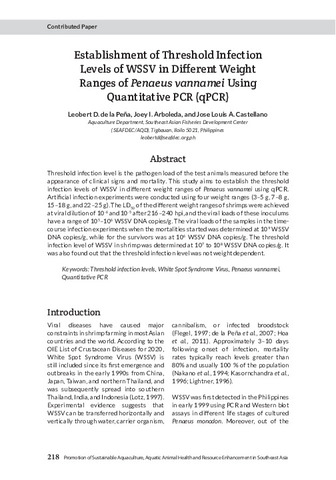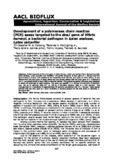Establishment of threshold infection levels of WSSV in different weight ranges of Penaeus vannamei using quantitative PCR (qPCR)
- Global styles
- MLA
- Vancouver
- Elsevier - Harvard
- APA
- Help
Share
Abstract
Threshold infection level is the pathogen load of the test animals measured before the appearance of clinical signs and mortality. This study aims to establish the threshold infection levels of WSSV in different weight ranges of Penaeus vannamei using qPCR. Artificial infection experiments were conducted using four weight ranges (3–5 g, 7–8 g, 15–18 g, and 22–25 g). The LD50 of the different weight ranges of shrimps were achieved at viral dilution of 10-6 and 10-5 after 216–240 hpi, and the viral loads of these inoculums have a range of 105–106 WSSV DNA copies/g. The viral loads of the samples in the timecourse infection experiments when the mortalities started was determined at 109 WSSV DNA copies/g, while for the survivors was at 106 WSSV DNA copies/g. The threshold infection level of WSSV in shrimp was determined at 107 to 108 WSSV DNA copies/g. It was also found out that the threshold infection level was not weight dependent.
Suggested Citation
de la Pena, L. D., Arboleda, J. I., & Castellano, J. L. A. (2021). Establishment of threshold infection levels of WSSV in different weight ranges of Penaeus vannamei using quantitative PCR (qPCR). In F. A. Aya, L. D. de la Peña, N. D. Salayo, & E. A. Tendencia (Eds.), Proceedings of the International Workshop on the Promotion of Sustainable Aquaculture, Aquatic Animal Health, and Resource Enhancement in Southeast Asia (pp. 218–228). Tigbauan, Iloilo, Philippines: Aquaculture Department, Southeast Asian Fisheries Development Center.
Type
Conference paperISBN
9789719931102 (Print); 9789719931119 (PDF)
Except where otherwise noted, this item's license is described as Attribution-NonCommercial-ShareAlike 3.0 IGO
Related items
Showing items related by title, author, creator and subject.
-
Immunization regimen in Asian sea bass (Lates calcarifer) broodfish: A practical strategy to control vertical transmission of nervous necrosis virus during seed production
Pakingking, Rolando V., Jr. ; de Jesus-Ayson, Evelyn Grace; Reyes, Ofelia; Bautista, Norwell Brian (Elsevier, 2018-08)
Outbreaks of viral nervous necrosis (VNN) in Asian sea bass (Lates calcarifer) at the larval stages via vertical transmission of nervous necrosis virus (NNV) from asymptomatic broodfish remain as a major deterrent during ...
; de Jesus-Ayson, Evelyn Grace; Reyes, Ofelia; Bautista, Norwell Brian (Elsevier, 2018-08)
Outbreaks of viral nervous necrosis (VNN) in Asian sea bass (Lates calcarifer) at the larval stages via vertical transmission of nervous necrosis virus (NNV) from asymptomatic broodfish remain as a major deterrent during ... -
Prevalence of viral nervous necrosis (VNN) virus in wild-caught and trash fish in the Philippines
de la Peña, Leobert D.; Suarnaba, Vonnie S.; Capulos, Geimbo C.; Santos, Mary Nia M. (European Association of Fish Pathologists, 2011)Viral nervous necrosis (VNN) caused by piscine nodavirus is a devastating disease affecting mainly marine finfish. In the Philippines, VNN was first reported in hatchery-reared grouper (Epinephelus coioides) broodstock in ... -
Development of a polymerase chain reaction (PCR) assay targeted to the dnaJ gene of Vibrio harveyi, a bacterial pathogen in Asian seabass, Lates calcarifer
Caipang, Christopher M. A.; Pakingking, Rolando V., Jr. ; Apines-Amar, Mary Jane S.; Huyop, Fahrul; Bautista, Norwell B. (Bioflux, 2011)
Partial sequence of the dnaJ gene of Vibrio harveyi, which was isolated from diseased juvenile Asian seabass, Lates calcarifer was identified. The partial sequence of dnaJ gene of V. harveyi was 447 bp and shared at least ...
; Apines-Amar, Mary Jane S.; Huyop, Fahrul; Bautista, Norwell B. (Bioflux, 2011)
Partial sequence of the dnaJ gene of Vibrio harveyi, which was isolated from diseased juvenile Asian seabass, Lates calcarifer was identified. The partial sequence of dnaJ gene of V. harveyi was 447 bp and shared at least ...







